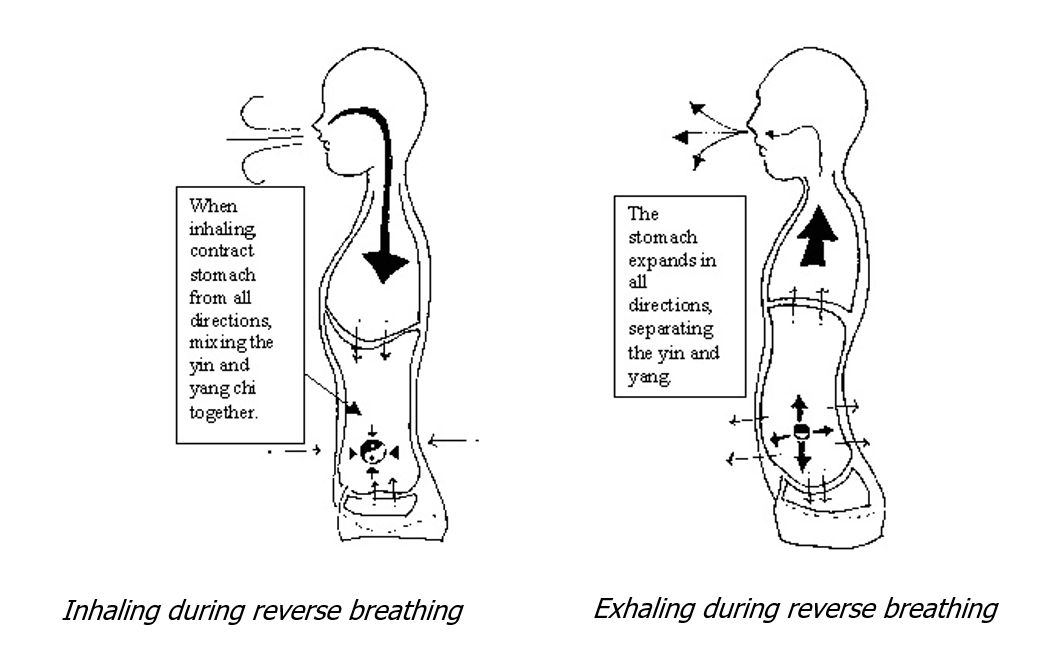Reverse Breathing: Enhancing Qi Pressure Through Controlled Compression
Reverse breathing is a powerful technique for enhancing Qi pressure and maximising energy absorption in the body.
In exercise #1, we created pressure in the breath by holding our breath for a few seconds. This elongated pressurising resulted in an energising of the body as it had some more time to absorb the Qi pressure.
The following exercise seeks to elongate the amount of time that the breath is held under pressure by contracting the abdomen during both inhalation and exhalation. This is a process called “reverse breathing”.
Unlike normal abdominal breathing, where the abdomen expands on inhalation and contracts on exhalation, reverse breathing maintains compression throughout both phases of the breath. This results in a prolonged period where Qi is held under pressure, allowing for greater internal absorption, circulation, and retention.
In daily life, reverse breathing occurs naturally when we need to generate more power and energy — such as during intense physical exertion, weightlifting, martial arts, or moments of deep focus and determination. Taoists recognised this instinctive breathing pattern and refined it into a systematic practice for cultivating and strengthening internal Qi.
By practicing reverse breathing, we increase the body’s ability to store and regulate Qi, build internal strength, and develop greater control over breath and energy flow.
Qi moves most effectively when kept under controlled pressure. By reversing the natural breathing pattern, we sustain compression of the internal cavities, creating a pressurised energy system.
Key Insights and Benefits of Reverse Breathing
- Prolonged Qi Absorption – Since Qi remains under pressure for an extended period, more energy is absorbed and stored.
- Strengthens the lower tan tien – This practice amplifies Qi pressure in the lower energy centre, making it an ideal technique for energy storage and martial arts training.
- Enhances Internal Stability – Reverse breathing strengthens the fascia, diaphragm, and core muscles, reinforcing the structural integrity of the body.
- Optimises Oxygen Utilisation – This technique increases oxygen efficiency, expanding lung capacity and improving breath control.
- Refines Mind-Body Awareness – The precise control required for reverse breathing deepens sensitivity to Qi movement and fosters a greater sense of internal connection.
- Strengthens the Nervous System – The pressurised breath cycle strengthens the nervous system, enhancing calmness, focus, and mental clarity.
Precautions for Reverse Breathing
- Beginners should not hold the breath for too long—this can lead to dizziness or discomfort.
- If you experience lightheadedness, return to normal abdominal breathing and rest.
- Avoid practicing on a full stomach—perform the exercise before meals or after digestion.
- Reverse breathing should be avoided by those with high blood pressure, cardiovascular conditions, or during pregnancy.

Practice Guide
Please watch the video below for this practice.
[INSERT VIDEO]
A written description of the practice is provided at the Exercise Files tab.
After you have completed the exercise, please note your experience in your Course Journal.
Notice that the feeling of pressure is maintained during both the inhalation and exhalation. In fact, during the process, the breath (and the Qi) is kept under pressure throughout. This longer period of time with the Qi under pressure allows the body to absorb the Qi much more easily, and contributes to increasing Qi pressure in the body.
Note: with reverse breathing, we want our diaphragm lowered during inhalation. This can take some time to develop the inner sensitivity to perfect.
